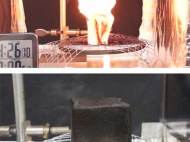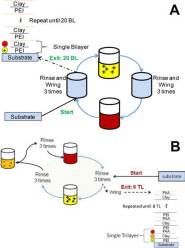Clay-based trilayer fire retardant for polyurethane foam
 National Institute of Standards and Technology (NIST) researchers developed a sustainable flame retardant technology for polyurethane foam. Based on clay, the new flame retardant coating can easily be applied onto home furnishings made of polyurethane foam – a material widely used for furniture cushions, carpet padding, children’s car seats, and other items – without affecting its softness.
National Institute of Standards and Technology (NIST) researchers developed a sustainable flame retardant technology for polyurethane foam. Based on clay, the new flame retardant coating can easily be applied onto home furnishings made of polyurethane foam – a material widely used for furniture cushions, carpet padding, children’s car seats, and other items – without affecting its softness.
To date, researchers have built up coatings by stacking thin layers in pairs that are held together by basic electrical attraction. With no clay present, just a pure polymer, a thick coating is formed rapidly, but it isn’t a fire retardant. With clay in every other layer, either the coating is too thin or the clay content is too low to be an effective fire retardant.
The NIST team came up with a solution by creating trilayers (3-layer) consisting of a positively charged bottom topped by two negatively charged layers. Under most circumstances, the two negative layers would repulse each other, but it turns out that hydrogen bonds formed between the two negative layers and overcame this repulsive force. The fast-forming resulting trilayer forms a thick and high concentration clay coating on polyurethane foam.
In comparison to traditional bilayer (2-layer) coatings, the new coating requires at least 5 times fewer total layers to contain 6 times more clay and 10 times greater thickness. Compared with amounts of current flame retardant applied to polyurethane foam, only half as much of the new clay-based coating was required to achieve comparable levels of performance.
According to published results, the eight trilayer system thoroughly coated all internal and external surfaces of the porous polyurethane foam, creating a clay brick wall barrier that reduced the foam flammability by as much as 17 percent of the peak heat release rate and 21 percent of the total burn time.
The thick, fast-forming coating that the NIST team created has a uniformly high concentration of flame-inhibiting clay particles, and it adheres strongly to the polyurethane foam. Only a few hundred nanometers thick, the final coating is transparent and the foam still has unnoticeable change in properties regarding the softness, support and feel.
“In effect, we can build the equivalent of a flame-retarding clay wall on the foam in a way that has no adverse impact on the foam manufacturing process”, said Rick Davis, NIST fire researcher. “Our clay-based coatings perform at least as well as commercial retardant approaches, and we think there’s room for improvement. We hope this new approach provides industry with practical alternative flame retardants.”
For more information, you can read the article published in the journal ACS Macro Letters: “Innovative approach to rapid growth of highly clay-filled coatings on porous polyurethane foam” [1.9MB PDF].










Sorry for my bad English. Thank you so much for your good post. Your post helped me in my college assignment, If you can provide me more details please email me.